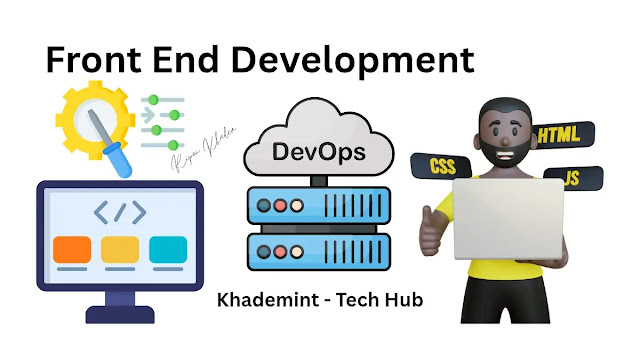A detailed guide on what Front-End Development is, how to learn it, what tools you need, and the best frameworks and skills for 2025.
What is Front-End Development?
Front-End Development is the part of a website that a user can directly see and use. This part is also called the client side. That is, the design, images, text or buttons that you see when you enter the website are all the result of Front-End Development.
HTML, CSS and JavaScript are mainly used for this work. In addition to this, many other tools, frameworks and design concepts are also required to be a successful Front-End Developer.
Get More Information Best Technical SEO Factors.
Role of Front-End Developer
The main job of a Front-End Developer is to create the interface of a website or web application. Their work includes:
Creating web pages according to design
Creating responsive layout
Maintaining browser compatibility
Ensuring UI/UX
Improving website speed
Essential technologies for Front-End Development
HTML (HyperText Markup Language)
HTML creates the structure of a webpage. The headings, paragraphs, tables, and images you see are organized with HTML.
Webpage styling is done using CSS (Cascading Style Sheets)
Background color, font size, margins, padding, grid layout, etc. with CSS.
JavaScript brings dynamism to the webpage.
For example, clicking on a button will open a popup, or if the user submits a form, its response can be shown.
Front-End Frameworks Currently,
many Front-End Frameworks are being used that make the work easy and fast. Some popular Frameworks:
React.js
Angular
Vue.js
Svelte
Next.js
Responsive Web Design and Mobile-first Approach Currently, most people browse the web from mobile.
Therefore, Mobile-first Design is followed to make the website mobile-friendly. Websites are viewed well on different screens by using CSS Media Query, Flexbox, Grid.
Importance of UI UX Design UI (User Interface) design and UX (User Experience) are the lifeblood of Front-End Development.
A website should not only be beautiful, it should also be easy to understand and user-friendly.
Some principles are followed to ensure UI UX:
Minimal Design
Consistent Layout
Fast Load Time
Accessibility (Design suitable for people with special needs)
Guide to Becoming a Front-End Developer
Step 1: Learn the Basics
HTML5, CSS3, JavaScript DOM Manipulation CSS Flexbox & GridStep 2: Intermediate Level
Responsive Web Design CSS Preprocessors (SASS, SCSS) Version Control (Git) Webpack, BabelStep 3: Advanced Tools and Concepts
JavaScript Framework (React/Angular/Vue) REST API Performance Optimization Lighthouse Audit Code Splitting.Get More Information Python Programming Language.
(US, UK, CA, AU, NZ, SG, IE, NL, FR, CH) If you are targeting an international market (United States, United Kingdom, Canada, Australia, New Zealand, Singapore, Ireland, Netherlands, France, Switzerland) audience Do:
Use hreflang tags Use geo-specific keywords like: "Responsive web design services in UK" Select Local Server Location Use Google My Business/Google Business front-End Developer ToolsCode Editor: Visual Studio Code
Version Control: Git & GitHub
UI Design Tool: Figma, Adobe XD
Browser Dev Tools: Chrome DevTools
Terminal: Command Line or Bash
Testing Tools: Jest, Cypress
Performance Optimization Tips
Lazy Load Images Code Minification Cache Control File Serving Using CDN Use Efficient Fonts Keep JavaScript Bundle SmallFreelancing and Remote Job Opportunities
It is easy to find remote jobs for Front-End Developers these days. Especially in high demand on the following sites:
Upwork Freelancer Fiverr Toptal RemoteOK WeWorkRemotely You can create your own portfolio and get work there. If you do good work, clients refer you.Interview Preparation If you are looking for a job or internship,
prepare the following questions:
What is JavaScript Hoisting?
Difference between var, let, const What is Event Bubbling?What is the DOM?
Difference between Front-end & Back-end Promise and async-awaitTips for Building a Front-End Developer Portfolio
Get a domain name of your own (e.g., yourname.dev) Create an About, Skills, Projects, Contact Page Add a GitHub link Provide a live project linkFuture Trends (2025 and beyond)
AI Integrated UI Design Voice User Interface WebAssembly Micro Frontends Jamstack ArchitectureResources for Learning Front-End Development
freeCodeCamp MDN Web Docs CSS-Tricks JavaScript.info YouTube: Traversy Media, The Net Ninja Udemy / Coursera Courses.Get More Information PHP Vs Laravel.
FAQS
Q1: How long does it take to become a Front-End Developer?
A: It is possible to achieve job-level skills in 6-8 months by spending 2-3 hours a day.
Q2: Which framework is the best?
A: React.js is currently the most popular and flexible.
Q3: Which tools should I use to start?
A: Visual Studio Code, GitHub, Chrome DevTools
Q4: How do I start learning CSS?
A: First learn Flexbox and Grid well, then start learning Animation and Transitions.
Q5: How do I make a mobile-friendly site?
A: Use Media Query, Fluid Layout, and Touch Friendly UI.
If you really want to build a career online, start learning Front-End Development today. Increase your skills step by step, work on real projects, build a portfolio, and create opportunities to work with clients from anywhere in the world. Start now!

HTML and CSS: Design and Build Websites
A full-color introduction to the basics of HTML and CSS from the publishers of Wrox! Every day, more and more people want to learn HTML and CSS. This book offers a fresh approach, making it accessible to both aspiring designers and those looking to enhance their own websites.
Check it out on Amazon


.webp)
.webp)

.png)
.png)
.png)


